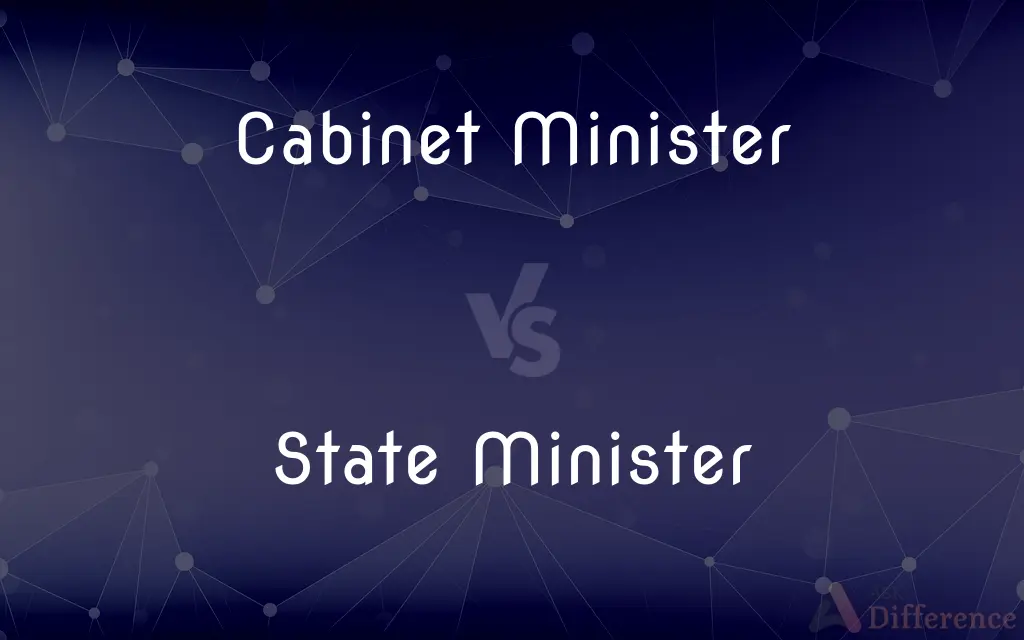Cabinet Minister vs. State Minister — What's the Difference?
By Tayyaba Rehman & Maham Liaqat — Published on July 11, 2024
Cabinet Ministers head major government departments and have a higher rank, while State Ministers assist Cabinet Ministers and manage specific department areas.

Difference Between Cabinet Minister and State Minister
Table of Contents
ADVERTISEMENT
Key Differences
Cabinet Ministers are senior officials in the government who lead major departments or ministries. They are responsible for formulating national policies and making key decisions in their areas of jurisdiction. On the other hand, State Ministers, also known as Ministers of State or junior ministers in some jurisdictions, assist Cabinet Ministers in specific areas within a department.
Cabinet Ministers are directly accountable to the legislature and the public for the actions and performance of their departments. They often represent their department's interests in the cabinet and play a crucial role in shaping government policy and direction. State Ministers, while they may also be accountable to the legislature, primarily report to their respective Cabinet Minister and focus on narrower or more specific areas within the larger departmental portfolio.
In terms of hierarchy and decision-making power within the government, Cabinet Ministers are at a higher level. They are often involved in high-level strategic decisions and may have a more prominent public profile, reflecting their broader responsibilities. State Ministers, while holding important roles within their departments, typically have a more focused scope of work and less autonomy in decision-making processes.
The appointment of Cabinet and State Ministers can vary depending on the country's political system. Cabinet Ministers are usually appointed from among the members of the majority party or coalition in the legislature, often based on political seniority, expertise, or loyalty to the party leadership. State Ministers might be appointed with similar considerations but can also be seen as a way to groom future Cabinet Ministers or to ensure representation from different factions within the party or coalition.
The roles and responsibilities of Cabinet and State Ministers may overlap in some areas, but their functions are designed to complement each other, ensuring efficient and effective governance. Cabinet Ministers rely on the support and assistance of State Ministers to fulfill the department's objectives and to handle the extensive workload of government administration.
ADVERTISEMENT
Comparison Chart
Rank and Authority
Higher rank, leads departments
Assists Cabinet Minister, lower rank
Responsibilities
Broad policy and department leadership
Specific areas within a department
Decision-Making Power
High, involved in key government decisions
More focused, less autonomy
Accountability
To the legislature and public
Primarily to Cabinet Minister
Role in Government
Central in formulating and implementing national policies
Supports Cabinet Minister, ensures detailed focus on specific issues
Compare with Definitions
Cabinet Minister
Plays a key role in national policy decisions.
Introduces legislation related to health care reform.
State Minister
Has authority in a more limited scope.
Makes decisions on specific projects under the education ministry.
Cabinet Minister
Directly accountable to the public and legislature.
Answers questions in parliament regarding departmental policies.
State Minister
May be seen as a stepping stone to higher office.
Gains experience and visibility for future leadership positions.
Cabinet Minister
Heads major government departments.
A Cabinet Minister might oversee the entire education system.
State Minister
Assists in managing specific areas of a department.
Focuses on primary education within the larger education department.
Cabinet Minister
Holds significant influence within the government.
Contributes to shaping the overall direction of government policy.
State Minister
Handles more focused tasks within the department.
Oversees the implementation of a new teacher training program.
Cabinet Minister
Involved in strategic government planning.
Participates in decisions on national security.
State Minister
Reports to the Cabinet Minister.
Provides updates and reports on the progress of assigned projects.
Common Curiosities
Are Cabinet Ministers more important than State Ministers?
Cabinet Ministers hold a higher rank and have broader responsibilities, making their roles generally considered more significant in the context of government operations.
Can a State Minister become a Cabinet Minister?
Yes, serving as a State Minister can be a stepping stone to becoming a Cabinet Minister, offering experience and visibility.
How are Cabinet and State Ministers appointed?
They are usually appointed by the head of government, often from among the members of the majority party or coalition in the legislature, based on various factors including expertise and political loyalty.
What kind of tasks might a State Minister handle?
A State Minister may oversee particular projects, initiatives, or sub-sectors within a larger department, such as renewable energy within an energy department.
Can a State Minister propose legislation?
Generally, the authority to propose legislation lies with Cabinet Ministers, but State Ministers may contribute to or support the legislative process within their area of expertise.
Can State Ministers attend cabinet meetings?
This varies by country; in some systems, State Ministers may attend cabinet meetings, but usually without the same rights as Cabinet Ministers.
How does the public perceive the roles of Cabinet and State Ministers?
Public perception can vary, but Cabinet Ministers are generally more visible and recognized due to their broader responsibilities and public roles.
Do State Ministers have any decision-making power?
Yes, they have decision-making power but within a more limited scope compared to Cabinet Ministers, focusing on specific areas within a department.
What is the main difference between a Cabinet Minister and a State Minister?
The main difference lies in their rank and scope of responsibilities; Cabinet Ministers lead departments and make broad policy decisions, while State Ministers assist in specific areas.
How does a State Minister's role vary across countries?
The specific duties and authority of a State Minister can vary significantly depending on the country's governmental structure and legal framework.
Is the number of State Ministers fixed?
The number of State Ministers can vary, depending on the government's structure and needs at any given time.
What is the impact of a State Minister's work on government policy?
State Ministers can have a significant impact on the development and implementation of government policy, particularly in their specialized areas, contributing to the overall effectiveness of the government.
Do Cabinet and State Ministers work together?
Yes, they work closely together, with State Ministers supporting Cabinet Ministers in achieving the department's goals.
What happens if a Cabinet Minister resigns?
If a Cabinet Minister resigns, a new appointment is usually made by the head of government to fill the vacancy, which could be a current State Minister or another eligible individual.
Are there any qualifications required to become a State Minister?
While specific qualifications can vary, State Ministers typically have relevant expertise, political experience, or other qualifications deemed necessary by the head of government.
Share Your Discovery

Previous Comparison
Dug Well vs. Drilled Well
Next Comparison
Methyl Chloride vs. Methylene ChlorideAuthor Spotlight
Written by
Tayyaba RehmanTayyaba Rehman is a distinguished writer, currently serving as a primary contributor to askdifference.com. As a researcher in semantics and etymology, Tayyaba's passion for the complexity of languages and their distinctions has found a perfect home on the platform. Tayyaba delves into the intricacies of language, distinguishing between commonly confused words and phrases, thereby providing clarity for readers worldwide.
Co-written by
Maham Liaqat













































